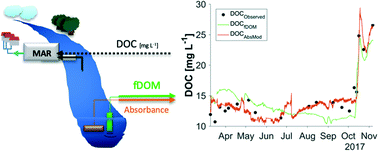Evaluating the accuracy of two in situ optical sensors to estimate DOC concentrations for drinking water production†
Abstract
Two in situ optical sensors, a single-excitation fluorescence-based sensor (fDOM) mounted on a multi-parameter EXO2 sonde (YSI), and a stand-alone, multispectral absorbance-based instrument (spectro::lyser, scan Messtechnik GmbH), were evaluated for their capability to (i) estimate river dissolved organic carbon (DOC) concentrations and (ii) provide oversight of drinking water production. The sensors were deployed between March and November 2017 in the river Fyris, which drains a mixed forested and agricultural 2003 km2 catchment and serves as a drinking water source by managed aquifer recharge. Grab samples were collected every 2 to 3 weeks and compared with logged sensor data collected at 15 minute intervals. The fDOM probe signal was used to estimate DOC concentrations in the range of 10.4 to 24.4 mg L−1 using linear regression (R2 = 0.71, RMSE = 2.5 mg L−1), after correction for temperature, turbidity and inner-filter effects. Temporal changes in DOC character associated with the mixed land use landscape, as indicated by optical indices, reduced this sensor accuracy for estimating DOC concentration. Nevertheless, humic substance concentrations, the fraction of DOC that is preferentially removed during artificial infiltration, were well captured. The spectrolyser signal was used to establish a 2-component partial least square model that captured DOC fluctuations from 10.2 to 29.4 mg L−1 (R2 = 0.92; RMSE = 1.3 mg L−1). This multiple-wavelength model (220 to 720 nm) effectively handled the changes in DOC composition while accurately estimating DOC concentrations. This study explores the advantages and limitations of optical sensors for their use in managed aquifer recharge and drinking water production in relation to DOC levels.



 Please wait while we load your content...
Please wait while we load your content...